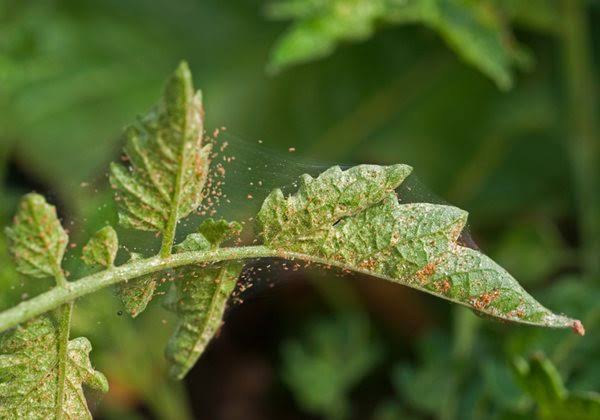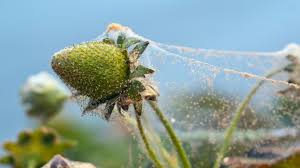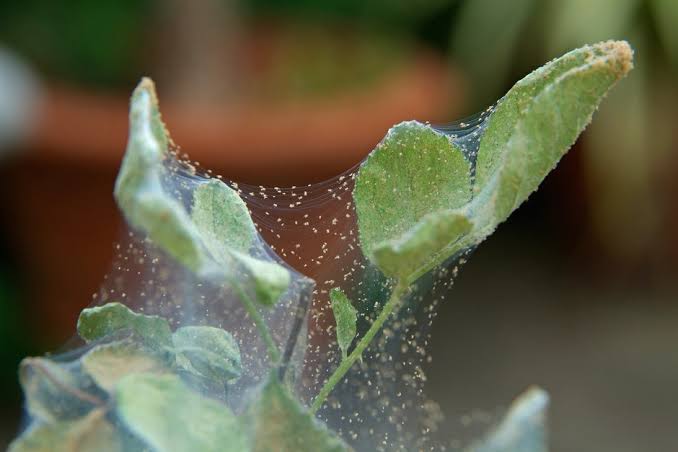Spider mites, scientifically known as Tetranychidae, are tiny arachnids that can cause significant damage to plants. These minuscule creatures, often not visible to the naked eye, belong to the family Tetranychidae and are members of the arachnid class, which includes spiders and ticks.
These pesky mites are a common pest in gardens and agricultural fields, and they feed on plant sap by piercing the plant cells with their specialized mouthparts. Despite their small size, spider mites can reproduce rapidly, leading to infestations that can harm the overall health of plants.
The damage caused by spider mites is evident through the stippling or yellowing of leaves, as they suck the chlorophyll from plant cells. Additionally, fine webbing may be visible, creating a telltale sign of their presence. This webbing not only protects the mites from predators but also aids in their movement between plants.
One of the challenges in dealing with spider mite infestations is their ability to develop resistance to pesticides. This adaptability makes it crucial for farmers and gardeners to employ integrated pest management strategies, which may include the use of natural predators, such as ladybugs, or the periodic application of insecticidal soaps.
Preventing spider mite infestations involves maintaining proper plant hygiene, ensuring adequate humidity levels, and regularly inspecting plants for any signs of infestation. Early detection is key to effective control, as prompt action can prevent the mite population from reaching damaging levels.
However, spider mites may be small, but their impact on plants can be significant. Understanding their biology, habits, and implementing appropriate control measures are essential for maintaining healthy crops and gardens.
Read Also: Tamarillos: History, Nutrition, Health Benefits and Growing Guide
Plants Affected by Spider Mites (Tetranychidae)

Spider mites are notorious for affecting a wide variety of plants, spanning both ornamental and agricultural species. These tiny arachnids do not discriminate and can infest plants across different botanical families. Some of the common plants affected by spider mites include:
1. Rose Plants: Spider mites often find their way to rose bushes, causing damage to the leaves and affecting the overall aesthetics of these beloved flowers.
2. Vegetable Crops: Various vegetable crops, such as tomatoes, cucumbers, and beans, are susceptible to spider mite infestations. The damage can lead to reduced yields and compromised plant health.
3. Fruit Trees: Orchards with fruit trees, including apple, pear, and peach trees, may face challenges from spider mites. These pests can weaken the trees and impact fruit quality.
4. Strawberries: Strawberry plants are not immune to spider mite attacks. Infestations can result in decreased fruit production and affect the overall vitality of the plants.
5. Ornamental Plants: Numerous ornamental plants, including azaleas, hibiscus, and marigolds, can fall victim to spider mites. The damage may manifest as discoloration and stunted growth.
6. Houseplants: Spider mites can also find their way indoors, infesting houseplants such as spider plants, ivy, and palms. Indoor environments with low humidity levels can be conducive to spider mite development.
7. Field Crops: In agricultural settings, crops like soybeans, corn, and cotton can suffer from spider mite infestations. These pests have the potential to reduce crop yields and compromise the quality of harvested produce.
Understanding the diverse range of plants that can be affected by spider mites is crucial for implementing proactive measures to prevent infestations and protect the health of plant populations. Regular monitoring and timely intervention are essential components of effective spider mite management.
Damages Caused by Spider Mites

Spider mites inflict various damages on plants, affecting their overall health and vitality. The consequences of a spider mite infestation include:
1. Stippling and Yellowing of Leaves: One of the primary indicators of spider mite damage is the stippling effect on leaves. As these tiny pests feed on plant sap, they pierce the plant cells, leading to small, pale spots on the leaves. This stippling can progress, causing the leaves to yellow and eventually drop.
2. Reduced Photosynthesis: Spider mites extract chlorophyll from plant cells during feeding, hindering the plant’s ability to undergo photosynthesis. Reduced photosynthesis limits the plant’s capacity to produce energy and vital nutrients, negatively impacting its growth and development.
3. Weakened Plant Immunity: Prolonged infestations weaken the plant’s natural defenses. Spider mites compromise the integrity of plant cells, making them more susceptible to other stress factors, diseases, and secondary pest invasions.
4. Premature Leaf Drop: Severe spider mite infestations can lead to premature leaf drop. As the mites continue to feed on plant sap, the leaves become weakened and may eventually fall off, further diminishing the plant’s ability to thrive.
5. Webbing Formation: Some species of spider mites produce fine silk webbing on the infested plants. While this webbing provides protection for the mites, it can also interfere with plant functions, reduce aesthetic appeal, and create an environment conducive to the development of fungal diseases.
6. Reduced Crop Yields: In agricultural settings, spider mite damage can result in reduced crop yields. Crops may produce fewer fruits or seeds, leading to economic losses for farmers.
7. Impact on Aesthetics: Ornamental plants in gardens and landscapes can suffer aesthetically from spider mite infestations. The visible signs of stippling, yellowing, and webbing diminish the overall visual appeal of the plants.
8. Development of Pesticide Resistance: Over time, spider mites can develop resistance to certain pesticides, making control measures less effective. This resistance poses a challenge for farmers and gardeners relying on chemical interventions.
Understanding the diverse range of damages caused by spider mites underscores the importance of early detection and proactive management to mitigate the negative effects on plants and crops. Integrated pest management strategies that include cultural, biological, and chemical controls are often essential for effective spider mite control.
Read Also: Ugli Fruit: History, Nutrition, Health Benefits and Growing Guide
Control and Preventive Measures

Effective control and preventive measures are crucial in managing spider mite infestations. Here are various strategies that can be employed:
1. Regular Monitoring: Periodically inspect plants for signs of spider mite infestation, including stippling, yellowing leaves, and fine webbing. Early detection allows for prompt intervention, minimizing potential damage.
2. Maintain Plant Hygiene: Keep plants clean and free from debris. Regularly remove fallen leaves and other plant material, as these can serve as hiding places for spider mites.
3. Adequate Watering: Maintain proper watering practices to ensure plants are adequately hydrated. Spider mites thrive in dry conditions, so maintaining moderate humidity levels can deter their proliferation.
4. Natural Predators: Encourage the presence of natural predators such as ladybugs, predatory mites, and lacewings. These beneficial insects feed on spider mites and can help keep their populations in check.
5. Pruning Infested Parts: If a plant has been infested, consider pruning and removing the affected parts. This can help reduce the overall mite population and prevent further spread.
6. Neem Oil and Horticultural Oils: Apply neem oil or horticultural oils as a natural and environmentally friendly solution to control spider mites. These oils suffocate the mites and disrupt their feeding.
7. Insecticidal Soaps: Use insecticidal soaps, which are effective against spider mites. These soaps break down the outer layer of the mites, leading to their demise. Ensure proper application and follow the recommended guidelines.
8. Miticide Application: In severe infestations, miticides specifically designed to target mites can be used. It’s important to rotate between different types of miticides to prevent the development of resistance.
9. Quarantine New Plants: Before introducing new plants to your garden or collection, quarantine them for a period to ensure they are not carrying spider mites or other pests.
10. Optimize Plant Nutrition: Ensure plants receive adequate nutrients to promote their overall health and resilience. Healthy plants are better equipped to withstand and recover from pest attacks.
Implementing an integrated approach that combines multiple control methods is often the most effective way to manage spider mite infestations. Regularly reassessing and adjusting these strategies based on the specific needs of the plants and the severity of the infestation is key to successful control and prevention.
Frequently Asked Questions (FAQs) About Spider Mites (Tetranychidae)
Q1: What are spider mites?
A1: Spider mites are tiny arachnids belonging to the family Tetranychidae. They are closely related to spiders and ticks and are known for feeding on plant sap, causing damage to a wide range of plants.
Q2: How can I identify spider mite damage on plants?
A2: Look for stippling or tiny pale spots on leaves, yellowing foliage, and fine webbing. These signs often indicate a spider mite infestation. Early detection is crucial for effective control.
Q3: What types of plants do spider mites commonly infest?
A3: Spider mites can infest a variety of plants, including roses, vegetables (e.g., tomatoes, cucumbers), fruit trees, strawberries, ornamental plants, and indoor houseplants.
Q4: How do spider mites reproduce?
A4: Spider mites reproduce rapidly, laying eggs on the undersides of leaves. The eggs hatch into nymphs, which mature into adults. Under favorable conditions, their populations can explode.
Q5: Can spider mites harm humans?
A5: Spider mites primarily feed on plants and are not known to harm humans. However, their bites can cause mild skin irritation in some cases.
Q6: What are some natural predators of spider mites?
A6: Natural predators include ladybugs, predatory mites, lacewings, and certain spiders. These beneficial insects help keep spider mite populations in check.
Q7: How can I prevent spider mite infestations?
A7: Practice regular monitoring, maintain plant hygiene, ensure proper watering, encourage natural predators, and quarantine new plants before introducing them to your garden.
Q8: Are chemical pesticides effective against spider mites?
A8: Chemical pesticides, including miticides, can be effective. However, overreliance may lead to resistance. It’s essential to rotate between different control methods and use pesticides judiciously.
Q9: Can spider mites develop resistance to pesticides?
A9: Yes, spider mites have the ability to develop resistance to pesticides over time. To avoid this, it’s recommended to rotate between different classes of miticides.
Q10: How do spider mites survive during winter?
A10: Some spider mite species overwinter as eggs, while others seek shelter in protected locations. They may become dormant during winter and resume activity when conditions improve in spring.
Remember, early identification and a combination of control measures are key to effectively managing spider mite issues in your plants.

